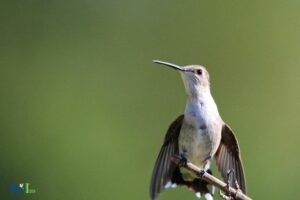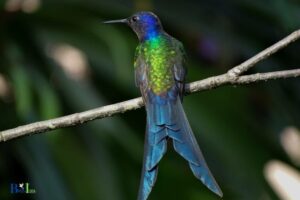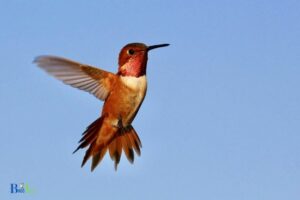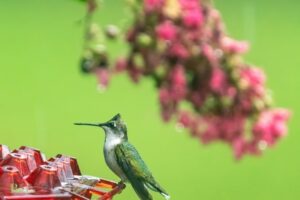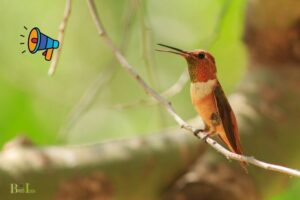Where Do Ruby Throated Hummingbirds Nest: Deciduous!
Ruby-throated hummingbirds build their nests in deciduous and mixed woodlands, often near water and at a height of 10-40 feet above ground.
Ruby-throated hummingbirds (Archilochus colubris) are small birds native to North America. They breed in eastern North America, from southern Canada to the Gulf of Mexico.
Their preferred nesting habitat includes deciduous and mixed woodlands, particularly those located near water sources such as rivers, lakes, or swamps.
The female builds the nest, choosing a location typically 10-40 feet above the ground. They often prefer trees with horizontal branches that provide some shelter and protection from the elements and predators.
The nest’s exterior is covered with lichen to blend in with the surrounding environment, while the interior is lined with soft plant materials for insulation and comfort.
These tiny nests are a testament to the ingenuity and adaptability of these remarkable birds in their chosen habitats.
6 Locations and Types of Ruby-Throated Hummingbirds’ Nests
| Habitat Type | Nest Location | Nest Description |
| Deciduous and mixed forests | Branches of trees or shrubs | A small cup-shaped nest made from plant-down and spider silk, lined with lichen and held together by spiderweb |
| Shrublands and meadows | Bushes, small trees, or vines | Same as above |
| Suburban and urban areas | Ornamental shrubs, trees, or hanging plants | Same as above |
| Edges of forests and woodland | Along the edge of a clearing or wooded trail | Same as above |
| Near fresh bodies of water | Trees or shrubs near the water’s edge | Same as above |
| Near nectar-rich flowering plants | Nearby trees or shrubs with a clear view | Same as above |
Key Takeaway
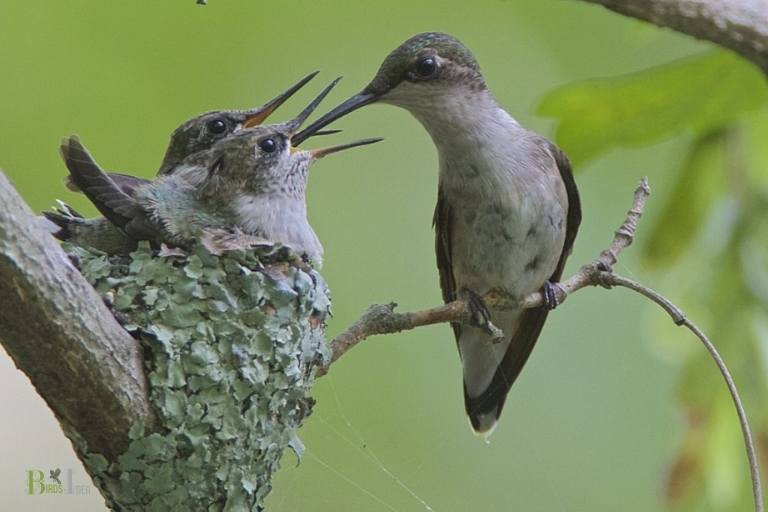
Five Facts About: Ruby-Throated Hummingbirds’ Nests
The Ruby-Throated Hummingbird
Description Of The Ruby-Throated Hummingbird
The ruby-throated hummingbird is a small, colorful bird that weighs only about 3 grams.
Here are a few key points that describe this fascinating bird:
- Named for the ruby-red patch on the throat of male ruby-throated hummingbirds, females display a more subtle green patch.
- The head, back, and tail of the ruby-throated hummingbird are a brilliant metallic green color, while the underside is lighter and mostly white.
- The wings of these birds are so small and compact that they create a humming sound when they fly, hence the name “hummingbird.”
- These little birds have a long, narrow beak that is ideal for sipping nectar from flowers, their primary source of food.
Explanation Of The Bird’S Breeding Habits
The ruby-throated hummingbird has some unique breeding habits that set it apart from other birds.
Here are a few things you should know:
- Males typically arrive at breeding grounds before females, scouting out the most desirable areas.
- Male ruby-throated hummingbirds will also perform an aerial display to attract females. They will fly high into the air, then dive down quickly while making a loud, buzzing sound with their wings.
- Once a female has been attracted, she will create a nest from plant material and spider webs, then lay 1-3 eggs.
- The female incubates the eggs for around two weeks, while the male defends the territory and brings her food.
- The eggs hatch and the chicks are fed a diet of insects and nectar until they are old enough to fly and forage on their own.
Understanding the ruby-throated hummingbird’s physical characteristics and breeding habits is key to appreciating the complexity of this tiny creature. Whether you’re a bird lover or just enjoy learning about nature, the ruby-throated hummingbird is a fascinating subject to explore.
Nesting Patterns Of Ruby-Throated Hummingbirds
Detailed Overview Of Where Ruby-Throated Hummingbirds Nest
Ruby-throated hummingbirds are migratory birds that breed in north america and winter in central america and mexico. These birds build their nests in areas with cover, such as trees and shrubs.
Here are some detailed overview of where ruby-throated hummingbirds usually nest:
- Suitable habitats: Hummingbirds nest in deciduous and mixed forests, woodland edges, and meadows.
- Location: Nests are typically built near sources of food and water such as the base of leaves, twigs, and branches.
- Nest type: Hummingbirds build compact, cup-shaped nests made with soft, insulative materials such as moss, lichens, and spider silk.
- Nest placement: These birds typically build their nests on the main trunk of a tree or on a branch.
- Height: The height of the nest varies depending on the location, but it is mostly found at a low height of about 10 to 20 feet above ground.
Discussion Of Key Factors That Influence Their Nesting Preferences
Many factors influence the nesting preferences of ruby-throated hummingbirds. Understanding these factors can help you create a suitable environment to attract hummingbirds to your yard.
Here are some factors to consider:
- Food sources: Ruby-throated hummingbirds prefer nesting areas that are rich in nectar sources. Planting flowers such as bee balm, cardinal flower, and trumpet creeper can provide a good source of nectar for hummingbirds.
- Cover and shelter: Hummingbirds look for places that provide shade and protection from predators. You can create cover by planting trees, shrubs, and adding birdhouses.
- Temperature and climate: The nesting preferences of ruby-throated hummingbirds change with humidity and temperature. These birds prefer areas with moderate temperatures and high humidity.
- Availability of nest building materials: Ruby-throated hummingbirds generally build their nests with soft, insulative materials such as moss and spider silk. Having these materials readily available can increase the chances of your yard being a hummingbird nesting spot.
These factors play a crucial role in the nesting preferences of ruby-throated hummingbirds. By creating an inviting environment, you can attract hummingbirds to your yard, and take pleasure in watching them build their nests and raise their young.
Finding Ruby-Throated Hummingbird Nests
Where Do Ruby Throated Hummingbirds Nest
Ruby-throated hummingbirds are beautiful, tiny birds that weigh less than a nickel, and they are the only hummingbirds that breed in the eastern united states.
These birds have a unique nesting pattern, and if you are a nature enthusiast, you might be wondering where the ruby-throated hummingbird nest is typically located.
Let’s dive in and find out how you can find these elusive nests.
Tips For Locating Ruby-Throated Hummingbird Nests
Finding a hummingbird nest is not an easy task, and locating a ruby-throated hummingbird nest is even more challenging because of the bird’s small size. However, these tips can help you locate a hummingbird nest more easily.
- Understand hummingbird behavior
Hummingbirds are notoriously territorial, and they will guard their nests fiercely. Watching the bird’s behavior, you can figure out where the nest is located. Hummingbirds prefer to make their nests in sheltered areas, such as the crook of a branch, the fork of a tree, or a bush.
- Look for nesting materials
Hummingbirds use different materials to build their nests, including feather down, spider silk, and moss. You can look for these materials in the surrounding areas to pinpoint the nest’s location. It’s essential to note that hummingbirds make their nests with small materials, making them difficult to see.
- Observe hummingbirds collecting nesting materials
If you see a hummingbird collecting nesting materials, take note of the location. Ruby-throated hummingbirds will come back to the same area, so it’s a promising sign that there is a nest nearby.
- Listen for the chirping
Once the baby birds hatch, they will chirp for food. Listen for the high-pitched chirping sound coming from the surrounding areas. If you hear it, follow the sound and try to locate the nest.
- Check out the height of the nest
Ruby-throated hummingbirds tend to build their nests high above the ground. The nests are usually located between six and ten feet above the ground in the crook of a branch or fork of a tree.
- Be patient
Finding a hummingbird nest can take time and patience, so keep watching the hummingbirds until you find their nest.
Explanation Of What To Look For When Trying To Find A Nest
Finding a hummingbird nest requires keen observation and patience. If you want to find a ruby-throated hummingbird nest, you need to focus on specific aspects.
Here is what you should look for when trying to find a ruby-throated hummingbird nest.
- The nest’s location: Ruby-throated hummingbirds nest in sheltered areas, such as the crook of a branch or the fork of a tree. Nests may also be in bushes or shrubs.
- The size of the nest: Hummingbird nests are tiny, and they may be the size of a gold ball. Ruby-throated hummingbird nests are typically two inches across and one inch deep.
- The materials used in building the nest: Ruby-throated hummingbirds use different materials to make their nests, including spider silk, moss, and plant down.
- The color of the eggs: Ruby-throated hummingbird eggs are pearl white, and they are about the size of a jellybean.
Now that you know the tips and what to look for when finding a ruby-throated hummingbird nest. These are helpful in your exploration to find these little beauties’ nest and enjoy watching the baby birds grow.
Protecting Ruby-Throated Hummingbird Nests
Where Do Ruby Throated Hummingbirds Nest: Protecting Ruby-Throated Hummingbird Nests
Every nature enthusiast is familiar with the ruby-throated hummingbird, the only species found in the eastern parts of north america. Watching these tiny creatures hover over flowers is a breathtaking spectacle, but our responsibilities to protect them don’t end there.
Apart from providing them with sustenance, we must protect their nesting habitats too. We’ll shed light on the importance of protecting these nests and various ways to do so effectively.
Importance Of Protecting The Nests
The ruby-throated hummingbird builds its nest with great care, usually in deciduous trees like maple or oak. Their nests are small, cup-shaped, and constructed from plant fibers, lichen, and spider silk.
Protecting these nests is crucial because:
- Nest destruction: Hummingbird nests can be easily destroyed by predators or inclement weather.
- Threat to the species: Destroyed nests may discourage parents from making another attempt, and we may lose a whole generation of these beautiful birds.
- Monitoring the nesting: Protecting nests also helps us keep track of the hummingbird population as we can monitor and engage in bird banding activities.
Outline Of Ways To Protect The Nests
Here are some ways by which you can protect the ruby-throated hummingbird’s nests:
- Keep pets away: If you have a cat or a dog that roams around outside, ensure that they are not a threat to the birds. Keep them inside when the birds are more likely to be around, especially during nesting season.
- Install birdhouses: Installing a birdhouse for the hummingbirds can act as an excellent substitute for their natural nesting spot. It can offer them a safe hideout from predators and unfavorable weather. Ensure that the birdhouse has proper ventilation and drainage.
- Avoid using pesticides: Chemicals like pesticides or herbicides are harmful to all birds and can have devastating effects on the hummingbirds’ delicate eco-system. Use alternative gardening methods that do not harm the birds’ natural habitat.
- Keep an eye on nests: If you spot a hummingbird nest, make sure to monitor the area around it for predators or weather changes. You could also keep a safe distance and observe the birds from afar.
- Spread awareness: Raising awareness about protecting hummingbird nests and its conservation can help make a considerable difference in these birds’ lives. Share your knowledge with people around you and educate them on the significance of these birds.
Protecting ruby-throated hummingbird nests goes beyond maintaining their food sources. It is vital that we ensure the safety and protection of the birds’ shelters as they play a crucial role in safeguarding their species.
By following the aforementioned steps, we can contribute to the well-being of these tiny creatures and do our bit in preserving wildlife.
FAQ For Where Do Ruby Throated Hummingbirds Nest
Where Do Ruby-Throated Hummingbirds Nest?
How Long Does It Take For A Hummingbird’S Nest To Be Built?
How Can You Attract Ruby-Throated Hummingbirds To Nest In Your Yard?
Do Ruby-Throated Hummingbirds Reuse Their Nests Each Year?
How Many Eggs Do Ruby-Throated Hummingbirds Lay?
Conclusion
After reading through this post, it is clear that ruby throated hummingbirds are fascinating creatures with a unique nesting pattern. From their preference for deciduous trees to their amazing ability to camouflage their nests, these birds never cease to amaze.
As we continue to expand our knowledge of hummingbirds, it is essential to appreciate their habitat and preserve it. To catch a glimpse of these tiny birds in action, consider planting a garden or installing a bird feeder. Watching them flit around in their natural habitat is truly a wonder to behold.
Understanding more about hummingbirds and their nesting habits can help us protect and conserve these amazing creatures for generations to come. With this newfound knowledge, we can view these tiny birds in a new light as they continue to capture our hearts and imaginations.

